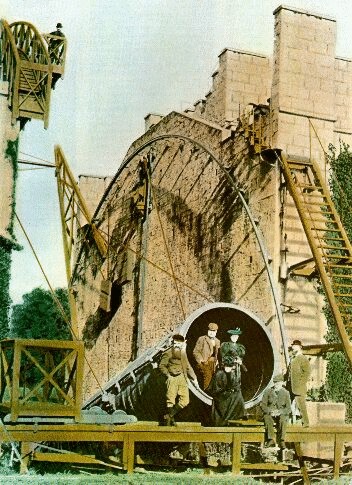 |
Visiting Birr Castle in 2001
Wolfgang Steinicke
Where is the largest Dobsonian located? You may think of the U.S. with monstrous 40 inchers of 5 m focal length, where dangerous climbing to the ocular is needed. Far from it! Add 32" to the aperture, multiply the focal length with 3.5 and you will get the size of Lord Rosse's gigantic reflector erected in the park of Birr Castle, Ireland. The old Lord - William Parsons, 3rd Earl of Rosse, to be precise - constructed in mid 19th century the world's largest telescope, called the "Leviathan of Parsonstown" (Fig. 1). It held the record until 1917, when the 100" Hooker reflector was completed on Mt. Wilson. The Leviathan had a metal mirror of 1.83 m and a focal length of 17 m . First Light was on Februar 15, 1845 observing the multiple star Castor, soon followed by M 67. Let's go back to Birr and its revolutionary achievements and results.
 |
Fig. 1 - The "Leviathan of Parsonstown" on a contemporary photo made by Lord Rosse's wife Mary, Countess of Rosse.
For Ireland the years after 1845 were extremely tragic. The "potato famine" costs the lifes of more than 1 Million people. Lord Rosse tried to help, which led to reducing most of his scientific work, especially observations with the new telescope. Rosse's aim was not to own the largest telescope. He wants to answere a fundamental question about the nature of the unresolved nebulae found by William Herschel. Are they mere gaseous masses in space or do the consist of myriads of stars, like our own Milky Way? The latter picture was already introduced by Kant in his theory of "world islands" [1]. Even the largest telescopes (like those build by Herschel) were not able to resolve the nebulae. A historic moment came in April 1845, when Lord Rosse pointed his new telescope to M 51 for the first time, discovering the nebula to have a spiral structure (Fig. 2). He created the term "spiral nebula" and concluded an inner rotation of a large system studded with stars. We now know, that Lord Rosse was right, but the physical proof of their extragalactic nature was found much later by Hubble using the 100" at Mt. Wilson. Until the end of 1850 Lord Rosse detected 14 spiral nebulae, making detailed sketches of their visual appearance, among them were M 33, M 95 and M 77. Today we can repeat his observations using much smaller instrument of 10 or 12" aperture [2]. Not only the social conditions were problematic but also the weather conditions. Lord Rosse, might be pretty frustrated, telling about the two weather situations at Birr: "just before rain" or "in rain". So the number of clear nights was pretty small - this hasn't changed up to now!
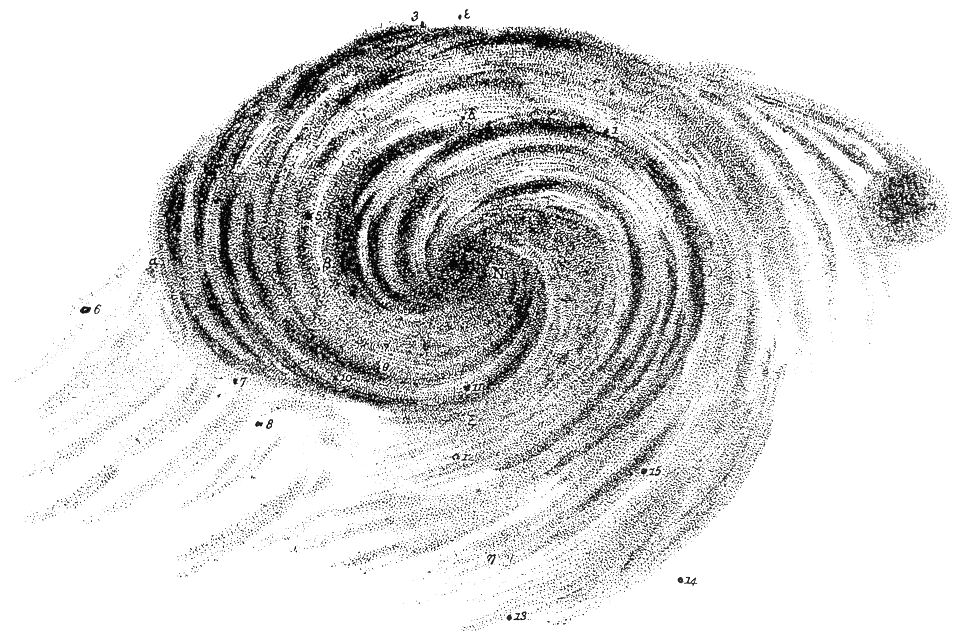 |
Abb. 2 - Lord Rosse's drwaing of M 51 showing its spiral structure.
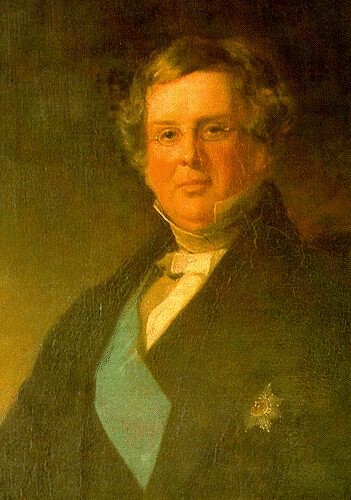 |
Fig. 3 - Contemporary painting of William Parsons, 3. Earl of Rosse.
William Parsons (Fig. 3) was born on June 17, 1800 in York, England. He later inherits his parents castle at Parsonstown (now Birr). Lord Rosse was interested in astronomy (as a great admirer of Herschel), mathematics and engineering sciences - a good combination to construct and use telescopes. He studied in Oxford and became a member of the Royal Astronomical Society in 1824. The Leviathan was Lord Rosse's second large telescope. The first, a 36 inch reflector with a metal mirror of 91 cm (see Fig. 4), looks very much like Herschel's famous 40ft reflector (mirror 1.2 m, focal length 12 m). Rosse's mirrors were made of speculum, an alloy of copper and tin, which was fairly reflective after polishing [3], not comperable with modern glas mirrors covered with aluminium. Metal mirrors are very heavy, the 72" weighed 4 tons! It took 3 years to build the Leviathan. The telescope with its very individual construction, a closed wooden tube (resembling a huge barrel), the mounting using strong ropes and the twin castle walls 15m tall, looks proud and impressive - I've never seen anything similar (Fig. 5).
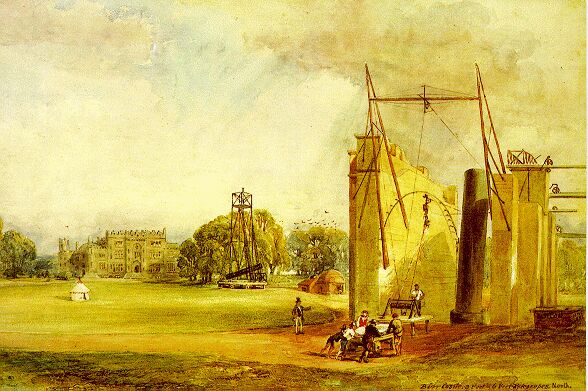 |
Fig. 4 - Lord Rosse's telescopes in the park of Birr Castle (seen in background): in front the 72" between the walls, behind the 36" with its wooden mounting.
To put the telescope into operation and to move the tube five people were needed, working on mechanical cranks with blocks and pulleys. Thanks to Lord Rosse's ingenious construction the huge mass could be moved astonishingly easy. It first looks that one can only observe in the meridian, but the tube is turnable 10 degrees east/west in azimut. Objects near the celestial equator can be tracked over 50 minutes, and at the zenit over 2 hours. The ocular can be reached by a movable observing platform. A guiding scope was not mounted, objects were searched using an ocular with large focal length. The lowest magnification was around 200x, showing a much smaller field of view compared with modern oculars, so finding was not easy! The observer could follow an object by turing nearby cranks for tube and platform motion. It might be pretty risky to stay on the 18 m high platform in a cold, dark winter night, looking and drawing still. Fortunately no accidents were reported. The mirror often tarnished and must then be changed with a second one.
Lord Rosse was assisted by George Stoney and R. J. Mitchell. Together they discovered 224 new objects, later included in Dreyer's „New General Catalogue" [4]. Beside the mentioned 14 spirals, he found another 81 cases of nebulae showing a spiral structure [5]. He accurately noted his observations and published all his results. Here are two examples:
NGC 6946 (galaxy in Cepheus, observed September 6, 1850): „New spiral, very fine but faint; 3 branches, of which two terminate in knots, a fourth branch north preceeding very doubtful." And exactly 5 years later: "The two following branches unite in one before meeting the nucleus, I certainly see a fourth branch preceeding which seems to join the other preceeding branch in the same way before reaching the nucleus. Of the four, those which terminate in knots are the brightest."
NGC 4151 (Seyfert-galaxy in Virgo, observed April 26, 1851): „Has a bright, round center with nucleus, then two dark spaces concentric with the nucleus and outside these faint nebulosity." And two days later: "Previous observation rather confirmed. The dark space certainly exists, but I cannot be sure the appendages are not part of spiral branches."
Not only spiral nebulae fascinated him. He also observed the moon, plantes, star clusters, diffuse and planetary nebulae (for M 1 he created the name "Crab Nebula" [6]). Lord Rosse died early at an age of 67 on October 31, 1867. For lasting impressions of Lord Rosse's times we have to thank his wife Mary, Countess of Rosse. She was a pioneer of photography and has captured many of her husband's activities (Fig. 1).
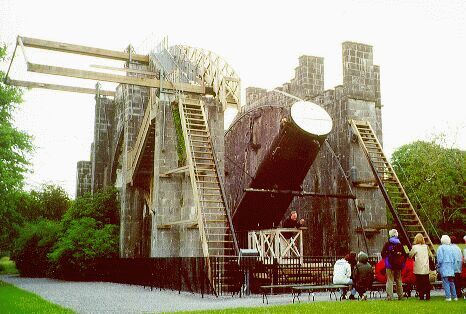 |
Fig. 5 - The completely restored instrument at my visit in June 2001.
After William Parsons' death the telescope was used by his son Lawrence (Fig. 6), 4th Earl of Rosse (1840-1908). Lawrence Parsons was assisted by Ralph Copeland, who observed with the 72" from 1871 to 1874, and well known by his discovery of a compact galaxy group in Leo, now called "Copeland Septett". Even more important was the visit of John Louis Emil Dreyer at Birr Castle from 1874 to 1878. Dreyer used the big telescopes to discover, confirm and catalogue nonstellar objects. This work made important contributions to thi „New General Catalogue" (NGC) he published in 1888 [7]. Lawrence Parsons interests changed from the nebulae (he discovered 41 NGC- and 9 IC-objects) to the moon. He equipped the lighter 36" with a parallactic mounting and an electric drive. By installing an electrical heat sensor at the front side of the tube he used the instrument to measure the temperature of the moon for the first time.
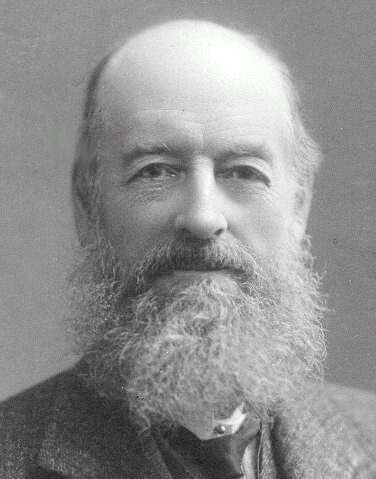 |
Fig. 6 - Lawrence Parsons, der 4. Earl of Rosse.
After Lawrence Parsons' death the Leviathan was dismantled, going more and more to ruin (the mirror was transfered to a museum in London). We all have to thank the initiative of the english amateur astronomer Patrick Moore, the help of the 6th Earl of Rosse and lokal organizations, that the telescope was completely restored after 90 years in 1997 [8]. It was equipped with a modern aluminium mirror and electro motors for positioning. Is is usable today? Indeed, there are local amateurs offering public observations. But this does not happen very often, reminding the catastrophic weather conditions!
I didn't have the luck of an observing session when I visited Birr Castle in June 2001 together with my wife. But it was very impressive to see the full function of the telescope and his mounting. We had time to admire all details (Fig. 7). The historic collection, placed in a little museum, contains many intersting legacies of the Earls: original drawings, notes and instruments. All looks very familiar and I felt no great differences comparing our present visual observation technics and results. Seeing also Lick, Palomar and Kitt-Peak one earlier trips, I felt here, at this cult place, that one is facing the very roots of "Deep-Sky" - just pure "Dobson feeling". A pilgrimage to Birr Castle is highly recommended!
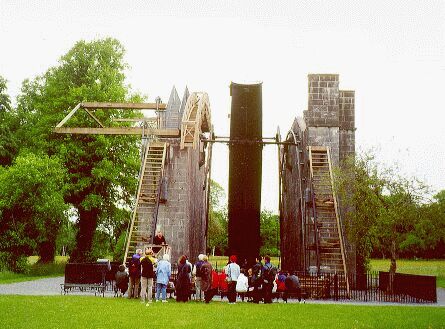 |
Abb. 7 - The new Leviathan pointing nearly to the zenit (June 2001).
Literature
[1] Hamel, J., Geschichte der Astronomie, Birkhäuser-Verlag 1998
[2] Buta, R., Observing Galaxies Visually, Sky & Telescope, Nov. 1979, S. 482
[3] Learner, R., Geschichte der Astronomie und die Entwicklung des Teleskops seit Galilei, Gondron Verlag 1991
[4] At present I'm working on an historic presentation of all NGC/IC Observers (nearly 150 persons), their biographies, discoveries and instruments. The resultat will be published at the NGC/IC Project and on this homepage.
[5] Thomson, M., Revealing the Rosse Spirals, Astronomy & Geology, August 2001
[6] Steinicke, W., Wie wär's mit der Nr. 1, interstellarum 17, S. 39 (2000)
[7] Steinicke, W., Digital Deep-Sky Data, Visual Observing and the NGC/IC Project, VdS-Journal, Sommer 2000, S. 49
[8] Moore, P., The Leviathan Reborn, Sky & Telescope, Nov. 1997, S. 52